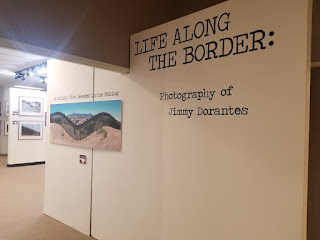~ Kayla Kirby, IVDM Education Specialist
"A fine beer may be judged with only one sip, but it's better to be thoroughly sure." -- Czech proverb
Guests traveled from all over the Imperial Valley, and even San Diego County, to visit the Imperial Valley Desert Museum this past Saturday for a night of beer tasting. Museum staff were happy to host our annual BeerFest, especially after missing out on the chance for fun last year.
The event sponsor, Alford Distributing, donated a variety of beers, including a pumpkin porter, passion fruit kombucha, a michelada lager, a fleet of IPAs, and more. The two favorite kinds of the night were the Sierra Nevada Brewing Co. Oktoberfest and the Karl Strauss Brewing Co. Boat Shoes.
 More than 80 guests sampled beer, toured the museum's exhibits, and generously participated and tried their luck with the night's raffles. As the keystone fundraiser for IVDM in its fall season, and the seasonal alternative to the institution's spring Wine Tasting and Silent Auction, raised funds from the night offer continued support for the museum's education and curation programs. The sounds of unleashed carbonation and the cascade of liquid hops into customized beer glasses resounded against the backdrop of classic rock blaring through the museum's exterior speakers, the ever-changing hues of LED event lighting, and the groans and cries of celebration among patrons of the night's featured horror-movie trivia game.
More than 80 guests sampled beer, toured the museum's exhibits, and generously participated and tried their luck with the night's raffles. As the keystone fundraiser for IVDM in its fall season, and the seasonal alternative to the institution's spring Wine Tasting and Silent Auction, raised funds from the night offer continued support for the museum's education and curation programs. The sounds of unleashed carbonation and the cascade of liquid hops into customized beer glasses resounded against the backdrop of classic rock blaring through the museum's exterior speakers, the ever-changing hues of LED event lighting, and the groans and cries of celebration among patrons of the night's featured horror-movie trivia game.
 Despite the windy night, guests and staff had a wonderful time. This year saw the museum move away from taps and kegs to instead offer bottle service, allowing for a greater variety of beer. Museum staff greatly enjoyed sharing that wider range of offerings and helping guests to find their new favorite flavor and style of beer!
Despite the windy night, guests and staff had a wonderful time. This year saw the museum move away from taps and kegs to instead offer bottle service, allowing for a greater variety of beer. Museum staff greatly enjoyed sharing that wider range of offerings and helping guests to find their new favorite flavor and style of beer!
We hope to see you all again -- and, hopefully, many new faces as well -- for the 2022 wine tasting event. Stay tuned for details... and happy drinking!























